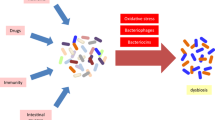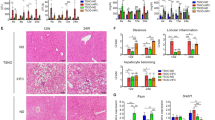Abstract
Purpose
Oxidized fats are known to induce oxidative stress resulting in the up-regulation of antioxidant enzymes, with the underlying mechanism being unclear. It is known, however, that the response of tissues to oxidative stress is mediated by redox-sensitive transcription factors such as NF-κB and Nrf2. The aim of this study, therefore, was to test the hypothesis that ingestion of an oxidized fat causes activation of these transcription factors in the small intestinal mucosa.
Methods
Female mice were randomly assigned to 2 groups of 12 mice each and administered orally by gavage either oxidized or fresh fat once per day.
Results
After 6 days of treatment, mice were killed, intestinal mucosa was isolated, and nuclear concentration of NF-κB and Nrf2 and expression of NF-κB- and Nrf2-regulated oxidative stress-responsive genes were determined. Oxidized fat markedly increased nuclear concentration of NF-κB and Nrf2 and transcript levels of oxidative stress-responsive genes, like aldo–keto reductase 1B8, vanin-1, glutathione peroxidase 1, and superoxide dismutase-1. In addition, oxidized fat increased the concentrations of PPAR-regulated genes.
Conclusions
The activation of oxidative stress-sensitive pathways likely reflects an adaptive response of the intestinal mucosa to prevent oxidative damage to the intestinal mucosa.



Similar content being viewed by others
References
Izaki Y, Yoshikawa S, Uchiyama M (1984) Effect of ingestion of thermally oxidized frying oil on peroxidative criteria in rats. Lipids 19:324–331
Kok TS, Harris PG, Alexander JC (1988) Heated canola oil and oxidative stress in rats. Nutr Res 8:673–684
Liu JF, Huang CJ (1995) Tissue α-tocopherol retention in male rats is compromised by feeding diets containing oxidized frying oil. J Nutr 125:3071–3080
Liu JF, Huang CJ (1996) Dietary oxidized frying oil enhances tissue α-tocopherol depletion and radioisotope tracer excretion in vitamin E-deficient rats. J Nutr 126:2227–2235
Eder K, Keller U, Hirche F, Brandsch C (2003) Thermally oxidized dietary fats increase the susceptibility of rat LDL to lipid peroxidation but not their uptake by macrophages. J Nutr 133:2830–2837
Keller U, Brandsch C, Eder K (2004) Supplementation of vitamins C and E increases the vitamin E status but does not prevent the formation of oxysterols in the liver of guinea pigs fed an oxidised fat. Eur J Nutr 43:353–359
Tsunada S, Iwakiri R, Fujimoto K, Aw TY (2003) Chronic exposure to subtoxic levels of peroxidized lipids suppresses mucosal cell turnover in rat small intestine and reversal by glutathione. Dig Dis Sci 48:210–222
Tsunada S, Iwakiri R, Fujimoto K, Aw TY (2003) Chronic lipid hydroperoxide stress suppresses mucosal proliferation in rat intestine: potentiation of ornithine decarboxylase activity by epidermal growth factor. Dig Dis Sci 48:2333–2341
Schreck R, Rieber P, Baeuerle PA (1991) Reactive oxygen intermediates as apparently widely used messengers in the activation of the NF-κB transcription factor and HIV-1. EMBO J 10:2247–2258
Sen CK, Packer L (1996) Antioxidant and redox regulation of gene transcription. FASEB J 10:709–720
Barnes PJ, Karin M (1997) Nuclear factor-κB: a pivotal transcription factor in chronic inflammatory diseases. N Engl J Med 336:1066–1071
Ben-Neriah Y, Schmidt-Supprian M (2007) Epithelial NF-κB maintains host gut microflora homeostasis. Nat Immunol 8:479–481
Niture SK, Kaspar JW, Shen J, Jaiswal AK (2010) Nrf2 signaling and cell survival. Toxicol Appl Pharmacol 244:37–42
Olivero David R, Bastida S, Schultz A, González Torres L, González-Muñoz MJ, Sánchez-Muniz FJ, Benedí J (2010) Fasting status and thermally oxidized sunflower oil ingestion affect the intestinal antioxidant enzyme activity and gene expression of male Wistar rats. J Agric Food Chem 58:2498–2504
Rojo AI, Salinas M, Martín D, Perona R, Cuadrado A (2004) Regulation of Cu/Zn-superoxide dismutase expression via the phosphatidylinositol 3 kinase/Akt pathway and nuclear factor-κB. J Neurosci 24:7324–7334
Andreadi CK, Howells LM, Atherfold PA, Manson MM (2006) Involvement of Nrf2, p38, B-Raf, and nuclear factor-κB, but not phosphatidylinositol 3-kinase, in induction of hemeoxygenase-1 by dietary polyphenols. Mol Pharmacol 69:1033–1040
Zhou LZ, Johnson AP, Rando TA (2001) NF-κB and AP-1 mediate transcriptional responses to oxidative stress in skeletal muscle cells. Free Radic Biol Med 31:1405–1416
Malone PE, Hernandez MR (2007) 4-Hydroxynonenal, a product of oxidative stress, leads to an antioxidant response in optic nerve head astrocytes. Exp Eye Res 84:444–454
Bull AW, Steffensen KR, Leers J, Rafter JJ (2003) Activation of PPARγ in colon tumor cell lines by oxidized metabolites of linoleic acid, endogenous ligands for PPARγ. Carcinogenesis 24:1717–1722
Delerive P, Furman C, Teissier E, Fruchart J, Duriez P, Staels B (2000) Oxidized phospholipids activate PPARα in a phospholipase A2-dependent manner. FEBS Lett 471:34–38
National Research Council (1985) Guide for the care and use of laboratory animals. Publication no. 85–23 (rev.). National Institutes of Health, Washington
Deutsche Gesellschaft für Fettwissenschaften (1994) Einheitsmethoden zur Untersuchung von Fetten, Fettprodukten, Tensiden und verwandten Stoffen. Stuttgart (Germany), Wissenschaftliche Verlagsgesellschaft
Sidwell CG, Salwin H, Benca M, Mitchell JH Jr (1954) The use of thiobarbituric acid as a measure of fat oxidation. J Am Oil Chem Soc 31:603–617
Recknagel RO, Glende EA Jr (1984) Spectrophotometric detection of lipid conjugated dienes. Methods Enzymol 105:331–337
International Union of Pure and Applied Chemistry (IUPAC) (2000) Determination of polar compounds, polymerized and oxidized triacylglycerols, and diacylglycerols in oils and fats. Pure Appl Chem 72:1563–1575
Butte W (1983) Rapid method for the determination of fatty acid profiles from fats and oils using trimethylsulfonium hydroxide for transesterification. J Chromatogr 261:142–145
Brandsch C, Ringseis R, Eder K (2002) High dietary iron concentrations enhance the formation of cholesterol oxidation products in the liver of adult rats fed salmon oil with minimal effects on antioxidant status. J Nutr 132:2263–2269
Ringseis R, Pösel S, Hirche F, Eder K (2007) Treatment with pharmacological peroxisome proliferator-activated receptor α agonist clofibrate causes upregulation of organic cation transporter 2 in liver and small intestine of rats. Pharmacol Res 56:175–183
Ringseis R, Muschick A, Eder K (2007) Dietary oxidized fat prevents ethanol-induced triacylglycerol accumulation and increases expression of PPARα target genes in rat liver. J Nutr 137:77–83
Penumetcha M, Khan N, Parthasarathy S (2000) Dietary oxidized fatty acids: an atherogenic risk? J Lipid Res 41:1473–1480
Staprans I, Rapp JH, Pan XM, Feingold KR (1993) The effect of oxidized lipids in the diet on serum lipoprotein peroxides in control and diabetic rats. J Clin Investig 92:638–643
Liu JF, Lee YW (1998) Vitamin C supplementation restores the impaired vitamin E status of guinea pigs fed oxidized frying oil. J Nutr 128:116–122
Schoonbroodt S, Piette J (2000) Oxidative stress interference with the nuclear factor-κb activation pathways. Biochem Pharmacol 60:1075–1083
Ringseis R, Piwek N, Eder K (2007) Oxidized fat induces oxidative stress but has no effect on NF-kappaB-mediated proinflammatory gene transcription in porcine intestinal epithelial cells. Inflamm Res 56:118–125
Ringseis R, Eder K (2004) Increases expression and activity of antioxidative enzymes and reduces the concentration of glutathione in the liver of rats. Int J Vitam Nutr Res 74:86–92
Levonen AL, Inkala M, Heikura T et al (2007) Nrf2 gene transfer induces antioxidant enzymes and suppresses smooth muscle cell growth in vitro and reduces oxidative stress in rabbit aorta in vivo. Arterioscl Thromb Vasc Biol 27:741–747
Takada Y, Mukhopadhyay A, Kundu GC, Mahabeleshwar GH, Singh S, Aggarwal BB (2003) Hydrogen peroxide activates NF-κB through tyrosine phosphorylation of IkBα and serine phosphorylation of p65. J Biol Chem 278:24233–24241
Srivastava S, Harter TM, Chandra A, Bhatnagar A, Srivastava SK, Petrash JM (1998) Kinetic studies of FR-1, a growth factor-inducible aldo-keto reductase. Biochemistry 37:12909–12917
Spite M, Baba SP, Ahmed Y, Barski OA, Nijhawan K, Petrash JM, Bhatnagar A, Srivastava S (2007) Substrate specificity and catalytic efficiency of aldo-keto reductases with phospholipid aldehydes. Biochem J 405:95–105
Berruyer C, Pouyet L, Millet V et al (2006) Vanin-1 licenses inflammatory mediator production by gut epithelial cells and controls colitis by antagonizing peroxisome proliferator-activated receptor γ activity. J Exp Med 203:2817–2827
Martin F, Penet MF, Malergue F et al (2004) Vanin-1(-/-) mice show decreased NSAID- and Schistosoma-induced intestinal inflammation associated with higher glutathione stores. J Clin Investig 113:591–597
Xu YZ, Thuraisingam T, de Lima Morais DA, Rola-Pleszczynski M, Radzioch D (2010) Nuclear translocation of ß-actin is involved in transcriptional regulation during macrophage differentiation of HL-60 cells. Mol Biol Cell 21:811–820
Long I, Suppian R, Ismail Z (2011) Increases in mRNA and DREAM protein expression in the rat spinal cord after formalin induced pain. Neurochem Res 36:533–539
Sahin K, Tuzcu M, Gencoglu H, Dogukan A, Timurkan M, Sahin N, Aslan A, Kucuk O (2010) Epigallocatechin-3-gallate activates Nrf2/HO-1 signaling pathway in cisplatin-induced nephrotoxicity in rats. Life Sci 87:240–245
Harada H, Sugimoto R, Watanabe A et al (2008) Differential roles for Nrf2 and AP-1 in upregulation of HO-1 expression by arsenite in murine embryonic fibroblasts. Free Radic Res 42:297–304
Lin W, Wu RT, Wu T, Khor TO, Wang H, Kong AN (2008) Sulforaphane suppressed LPS-induced inflammation in mouse peritoneal macrophages through Nrf2 dependent pathway. Biochem Pharmacol 76:967–973
Liu YC, Hsieh CW, Wenig YC, Chuang SH, Hsieh CY, Wung BS (2008) Sulforaphane inhibition of monocyte adhesion via the suppression of ICAM-1 and NF-kappaB is dependent upon glutathione depletion in endothelial cells. Vasc Pharmacol 48:54–61
Wagner AE, Ernst I, Iori R, Desel C, Rimbach G (2010) Sulforaphane but not ascorbigen, indole-3-carbinole and ascorbic acid activates the transcription factor Nrf2 and induces phase-2 and antioxidant enzymes in human keratinocytes in culture. Exp Dermatol 19:137–144
Liu GH, Qu J, Shen X (2008) NF-κB/p65 antagonizes Nrf2-ARE pathway by depriving CBP from Nrf2 and facilitating recruitment of HDAC3 to MafK. Biochim Biophys Acta 1783:713–727
Shibahara S (1988) Regulation of heme oxygenase gene expression. Semin Hematol 25:370–376
Alam J, Stewart D, Touchard C, Boinapally S, Choi AM, Cook JL (1999) Nrf2, a Cap’n’Collar transcription factor, regulates induction of the heme oxygenase-1 gene. J Biol Chem 274:26071–26078
Lavrovsky Y, Schwartzman ML, Levere RD, Kappas A, Abraham NG (1994) Identification of binding sites for transcription factors NF-kappa B and AP-2 in the promoter region of the human heme oxygenase 1 gene. PNAS 91:5987–5991
Chao PM, Chao CY, Lin FJ, Huang C (2001) Oxidized frying oil up-regulates hepatic acyl-CoA oxidase and cytochrome P450 4 A1 genes in rats and activates PPARα. J Nutr 131:3166–3174
Sülzle A, Hirche F, Eder K (2004) Thermally oxidized dietary fat upregulates the expression of target genes of PPARα in rat liver. J Nutr 134:1375–1383
Luci S, König B, Giemsa B, Huber S, Hause G, Kluge H, Stangl GI, Eder K (2007) Feeding of a deep-fried fat causes PPARα activation in the liver of pigs as a non-proliferating species. Br J Nutr 97:872–882
Zhou XR, Sun CH, Liu JR, Zhao D (2008) Dietary conjugated linoleic acid increases PPARγ gene expression in adipose tissue of obese rat, and improves insulin resistance. Growth Horm IGF Res 18:361–368
Martin G, Schoonjans K, Lefebvre AM, Staels B, Auwerx J (1997) Coordinate regulation of the expression of the fatty acid transport protein and acyl-CoA synthetase genes by PPARα and PPARγ activators. J Biol Chem 272:28210–28217
Bildirici I, Roh CR, Schaiff WT, Lewkowski BM, Nelson DM, Sadovsky Y (2003) The lipid droplet-associated protein adipophilin is expressed in human trophoblasts and is regulated by peroxisomal proliferator-activated receptor-γ/retinoid X receptor. J Clin Endocrinol Metab 88:6056–6062
Barclay TB, Peters JM, Sewer MB, Ferrari L, Gonzalez FJ, Morgan ET (1999) Modulation of cytochrome P-450 gene expression in endotoxemic mice is tissue specific and peroxisome proliferator-activated receptor-α dependent. J Pharmacol Exp Therap 290:1250–1257
Wagner AE, Boesch-Saadatmandi C, Breckwoldt D, Schrader C, Schmelzer C, Döring F, Hashida K, Hori O, Matsugo S, Rimbach G (2011) Ascorbic acid partly antagonizes resveratrol mediated heme oxygenase-1 but not paraoxonase-1 induction in cultured hepatocytes—role of the redox-regulated transcription factor Nrf2. BMC Complement Altern Med 11:1
Ristow M, Zarse K, Oberbach A, Klöting N, Birringer M, Kiehntopf M, Stumvoll M, Kahn CR, Blüher M (2009) Antioxidants prevent health-promoting effects of physical exercise in humans. Proc Natl Acad Sci USA 106:8665–8670
Acknowledgment
This study was supported by a grant from the Deutsche Forschungsgemeinschaft (DFG; grant no. RI 1537/1-1).
Author information
Authors and Affiliations
Corresponding author
Rights and permissions
About this article
Cite this article
Varady, J., Eder, K. & Ringseis, R. Dietary oxidized fat activates the oxidative stress-responsive transcription factors NF-κB and Nrf2 in intestinal mucosa of mice. Eur J Nutr 50, 601–609 (2011). https://doi.org/10.1007/s00394-011-0181-8
Received:
Accepted:
Published:
Issue Date:
DOI: https://doi.org/10.1007/s00394-011-0181-8




